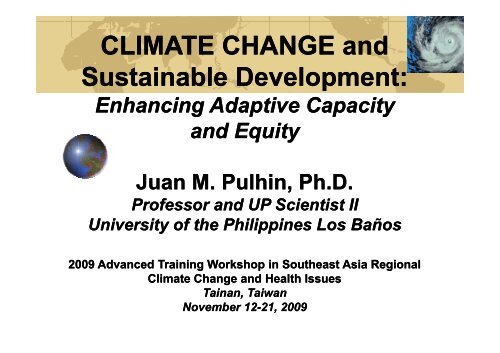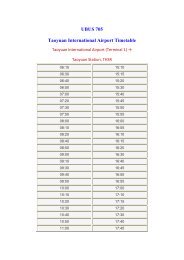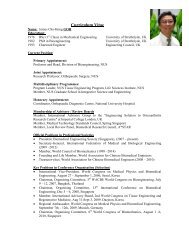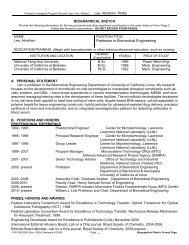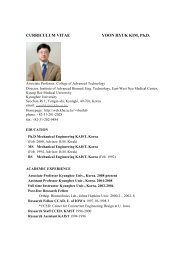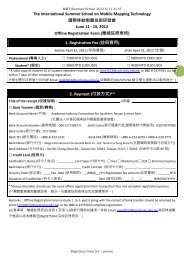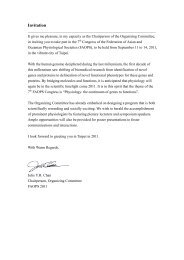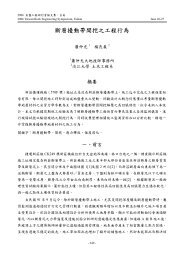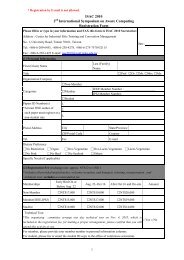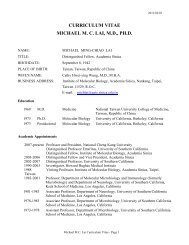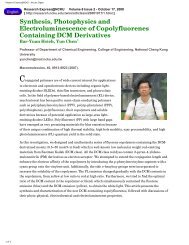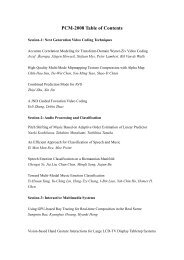2. Enhancing Adaptive Capacity and Equity
2. Enhancing Adaptive Capacity and Equity
2. Enhancing Adaptive Capacity and Equity
- No tags were found...
You also want an ePaper? Increase the reach of your titles
YUMPU automatically turns print PDFs into web optimized ePapers that Google loves.
CLIMATE CHANGE <strong>and</strong>Sustainable Development:<strong>Enhancing</strong> <strong>Adaptive</strong> <strong>Capacity</strong><strong>and</strong> <strong>Equity</strong>Juan M. Pulhin, Ph.D.Professor <strong>and</strong> UP Scientist IIUniversity of the Philippines Los Baños2009 Advanced Training Workshop in Southeast Asia RegionalClimate Change <strong>and</strong> Health IssuesTainan, TaiwanNovember 12-21, 21, 2009
Overview of the PresentationDefinition of TermsDeterminants of <strong>Adaptive</strong> <strong>Capacity</strong><strong>Adaptive</strong> <strong>Capacity</strong> <strong>and</strong> <strong>Equity</strong>Limits <strong>and</strong> Barriers to Adaptation<strong>and</strong> <strong>Adaptive</strong> <strong>Capacity</strong>Strengthening <strong>Adaptive</strong> <strong>Capacity</strong> inSEA
AdaptationDefinitionsAdjustment t in natural orhuman systems in response toactual or expected climaticstimuli or their effectsmay increase resilience <strong>and</strong>capacity to copereduces adverse effects <strong>and</strong>capitalize on opportunitiesBut mal-adaptation canexacerbate vulnerability
Examples of multilevel adaptive measures for some anticipatedheath outcomes of fglobal climate change (Patz, 1996)
Summary of Key Adaptation Options in theHealth Sector in SEA (ADB 2009)
Places of adaptation in the climatechange issue (Smitet al., 1999)
VulnerabilityDefinitionspropensity of human <strong>and</strong>ecological systems to sufferharm <strong>and</strong> their ability torespond to stresses imposedas a result of climate changeeffectsSociety’s vulnerability –influenced by its developmentpath, physical exposures, thedistribution of resources, priorstresses <strong>and</strong> social <strong>and</strong>government institutions
Determinants of <strong>Adaptive</strong> <strong>Capacity</strong>Personal attributesEducationIncomeKnowledge, etc.Economic developmentProvides greater access toresources <strong>and</strong> technologyTechnologyTechnological adaptationsnormally developed thru research
Determinants of <strong>Adaptive</strong> <strong>Capacity</strong>Social factorssocial capital, social networksvalues, perceptions, customs,traditions <strong>and</strong> levels ofcognitionGovernance structurespoliciesinstitutional mechanism <strong>and</strong>support
Factors Affecting Effectiveness of AdaptationStrategies during El Nino (Pulhin et al 2009)Predictors Crop Yield 1 HH Income 2 Farm water 3Access to hospital ‐21Access to road ‐85 1.55 1.64Access to municipal ii office 034 0.34 069 0.69Farm access to house ‐0.86Farm access to marketAwareness on climatevariability 652 6.52 281 <strong>2.</strong>81Ownership of l<strong>and</strong> 8.36No. of coping mechanisms 507 5.07Organizationalmembership 587 5.87 10.83* 1 Off-farm work; 2 Look for alternative food sources; 3 Get from other sources13
Factors Affecting Effectiveness of AdaptationStrategies during El Nino (Pulhin et al 2009)Predictors Crop Yield 1 HH Income 2 Farm water 3Financial barrier 49.75Socio‐cultural barrier 7.04 38.65Technological barrier 1<strong>2.</strong>9 24.04Institutional barrier ‐14.4Other barriers ‐11.9R Square 0.52 0.39 0.34R 0.72 0.63 058 0.58(Constant) 2<strong>2.</strong>21 40.80 30.03• To a certain extent, the presence of financial, socio-cultural <strong>and</strong>technological barriers may not necessarily limit the effectiveness ofadaptation strategies• Absence of /reduced institutional <strong>and</strong> other barriers tend to facilitateeffective adaptation14
<strong>Adaptive</strong> <strong>Capacity</strong> <strong>and</strong> <strong>Equity</strong><strong>Adaptive</strong> capacity is uneven acrosscountriesLow <strong>Adaptive</strong><strong>Capacity</strong>???Champagne Metaphor of Global disparityHigh <strong>Adaptive</strong><strong>Capacity</strong>
<strong>Adaptive</strong> capacity <strong>and</strong> <strong>Equity</strong><strong>Adaptive</strong> capacity isuneven within nationsdue to multiple stressesDistricts in India that rankhighest in terms ofvulnerability to: (a) climatechange <strong>and</strong> (b) importcompetition associatedwith iheconomicglobalisation, areconsidered to be doubleexposed (depicted withhatching). Adapted fromO’Brien et al. (2004).16
<strong>Adaptive</strong> <strong>Capacity</strong> <strong>and</strong> <strong>Equity</strong>Social <strong>and</strong> economicprocesses determine thedistribution of adaptivecapacitylocal-level adaptivecapacity are contextspecificshaped by socialnetworks <strong>and</strong> institutionsi iadaptive capacity is alsodifferentiated by age,class, gender, health <strong>and</strong>social status17
<strong>Adaptive</strong> capacity <strong>and</strong> <strong>Equity</strong>Small farmers in the Philippines are more vulnerableGroups Impacts Degree ofVulnerability(-) ImpactsBetter-off↓ production &Better copingfarmers income; ↔ food,mechanism - lowlivelihood, healthvulnerability↓ production,Poor coping“Little” farmers food, livelihood,mechanism – highhealth; more debtvulnerabilityEmployeesBusiness-persons (smallscale)↑ price ofcommodities↓ in sales“Average” copingmechanism –moderately vul.“Average” copingmechanism –moderately vul.18
LOCATION OF VULNERABLE PEOPLE AND PLACES IN BRGY. D.L.MAGLANOC, CARRANGLANF.C. OTICNORTHTO SAN JOSE PROVINCIAL ROAD TO CONVERSION Pantabangan N.E.MUN. HALLRESIDENTIALRESIDENTIALRESIDENTIALSAN VICENTERESIDENTIALG.S. ROSA ARIOSAN FRANCISCO ST.RESIDENTIALSAN JOAQUINLEGEND :BETTER-OFF FARMERSSAN BALTAZAR ST.“SMALL” FARMERSEMPLOYEESMALBANG CREEKBUSINESSPERSONSVULNERABLE AREAS
“Small farmers” in the Philippines has less effectiveadaptation strategies due to a combination of factorsGroupsBetter-offfarmers“Little”farmersStrategiesStore food <strong>and</strong> farminputs“5-6” loan; borrowfrom relatives; plantvegetables alongriver/other crops; workin nearby town; seekoverseas employment;engage in other jobsEffectivenessEffectiveSomeeffective;othersnotEmployeesAvail of loan; backyardEffectiveproject (e.g. piggery)Recommen-dationsLivelihood project;coop development;financial asstnce;estab. of GrainAgency accessibleto the poorBusiness- Store food supply <strong>and</strong> Effective “Price watch” topersons other farm inputsregulate prices(small-scale)
Limits <strong>and</strong> Barriers to Adaptation &<strong>Adaptive</strong> <strong>Capacity</strong>Adaptation ti will not necessarilymake the aggregate impacts ofclimate change negligible ibl orbeneficialIt can’t be assumed that allavailable adaptation measureswill actually be takenHigh adaptive capacity may notautomatically translate intosuccessful adaptations toclimate change21
Limits <strong>and</strong> Barriers to Adaptation &<strong>Adaptive</strong> <strong>Capacity</strong>Physical <strong>and</strong> EcologicallLimitsmay have critical thresholdsbeyond which some systemsmay not be able to adapt tochanging g climate conditionsDramatic climatic changesmay lead to transformationsof the physical environmentof a region that limit thepossibilities for adaptation22
Limits <strong>and</strong> Barriers to Adaptation &Technological Limits<strong>Adaptive</strong> <strong>Capacity</strong>decision-making underuncertainty may inhibit theadoption or development oftechnological solutions toclimate change adaptationtechnologies not equallyaccessible to all, <strong>and</strong> cancontribute to inequalitieswithin the community throughdifferential access toresources23
Limits <strong>and</strong> Barriers to Adaptation &Financial barriers<strong>Adaptive</strong> <strong>Capacity</strong>Financial barriers frominternational to local level limitsimplementation of adaptationmeasuresDeep financial poverty is afactor that constrains the useof seemingly gyinexpensivehealth measures, such asinsecticide-treated bed nets24
Reasons for adaptation <strong>and</strong> examples ofadaptation barriers of Philippine farmersADAPTATION REASONS BARRIERSPrayingVery effective, normal habit,None, no costGet water from othersourceAsset disposalOff‐farm workConstruction ofirrigation drainage/canaldone in combination with hard involvedworkAvailable in the nearby Costly, laborstreams/ creeks, continuous intensive, pipes aresupply of water especially for prone to theftvegetablesDepends on needs, easily Sold at a very lowdisposed, easy income sourcepriceAdditional income for the Skills dependent,family although may be limited, limitedno/ low cost involvedopportunities,costly/ high pricePrevent soil erosion, conserve Laborious, timesoil, no/ low costs involvedconsuming, capitalintensive
Limits <strong>and</strong> Barriers to Adaptation &Information <strong>and</strong>cognitive barriers<strong>Adaptive</strong> <strong>Capacity</strong>Individuals’ interpretation ofinformation is mediated bypersonal <strong>and</strong> societal values<strong>and</strong> priorities, personalexperience <strong>and</strong> othercontextual factorsPerceptions of climatechange risks are differing27
Limits <strong>and</strong> Barriers to Adaptation &Information <strong>and</strong>cognitive barriers<strong>Adaptive</strong> <strong>Capacity</strong>Perceptions of vulnerability<strong>and</strong> adaptive capacity areimportantAppealing to fear <strong>and</strong> guiltdoes not motivateappropriate adaptivebehaviour28
Limits <strong>and</strong> Barriers to Adaptation &Social <strong>and</strong> culturalbarriersIndividuals <strong>and</strong> groupsmay have different risktolerances as well asdifferent preferencesabout adaptationmeasures, depending ontheir worldviews, values<strong>and</strong> beliefs.<strong>Adaptive</strong> <strong>Capacity</strong>29
Strengthening <strong>Adaptive</strong> <strong>Capacity</strong>in Southeast Asia (ADB 2009)requires mainstreaming climatechange adaptation in developmentplanning, that is:making it an integral part ofsustainable development, povertyreduction <strong>and</strong> disaster riskmanagement strategies.
Strengthening <strong>Adaptive</strong> <strong>Capacity</strong>in Southeast Asia (ADB 2009)Stepping up efforts to raise publicawareness of climate change <strong>and</strong> its impact;Undertaking more research to betterunderst<strong>and</strong> climate change, its impact, <strong>and</strong>solutions, especially at local levels;<strong>Enhancing</strong> policy <strong>and</strong> planning coordinationacross ministries <strong>and</strong> different levels ofgovernment for climate change adaptation;
Strengthening <strong>Adaptive</strong> <strong>Capacity</strong>in Southeast Asia (ADB 2009)Adopting a more holistic approach tobuilding the adaptive capacity of vulnerablegroups <strong>and</strong> localities <strong>and</strong> their resilience toshocks; <strong>and</strong>Developing <strong>and</strong> adopting more proactive,systematic, <strong>and</strong> integrated approaches toadaptation in key sectors that are cost-effective <strong>and</strong> that offer durable <strong>and</strong> longtermsolutions.
Strengthening <strong>Adaptive</strong> <strong>Capacity</strong>in Southeast Asia (ADB 2009)Carefullyconsideringadaptationbarriers <strong>and</strong> maladaptationthatcan furtherincreasevulnerability <strong>and</strong>exacerbateinequity33
ThankYou forListening!


